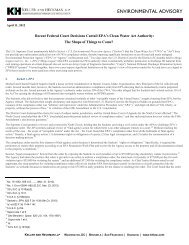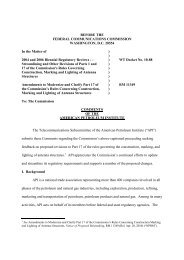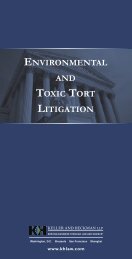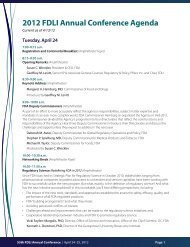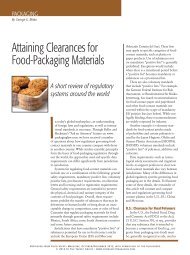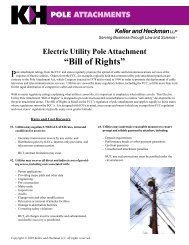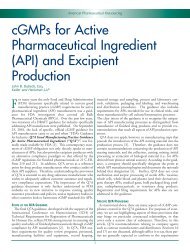A Practical Understanding of the Polymer ... - Keller Heckman
A Practical Understanding of the Polymer ... - Keller Heckman
A Practical Understanding of the Polymer ... - Keller Heckman
You also want an ePaper? Increase the reach of your titles
YUMPU automatically turns print PDFs into web optimized ePapers that Google loves.
Introduction<br />
determination <strong>of</strong> eligibility is on slippery, steep ground. Our advice: polymers<br />
whose identities and relevant characteristics cannot be sufficiently defined should<br />
be presumed to be ineligible for <strong>the</strong> exemption.<br />
Once a polymer is sufficiently defined, its eligibility may be determined. If<br />
eligible, <strong>the</strong> new polymer can be manufactured or imported immediately. Where<br />
applicable, this can be an immense benefit. However, by exempting certain polymers<br />
from premanufacture review, <strong>the</strong> EPA has given <strong>the</strong> responsibility <strong>of</strong> certification<br />
for this eligibility to individuals in businesses. At first glance, this burden may<br />
seem less than it actually is.<br />
In addition to recordkeeping, a one-time report is required for each polymer<br />
manufactured or imported under <strong>the</strong> exemption. Manufacturers and importers <strong>of</strong><br />
<strong>the</strong> exempt polymers must report <strong>the</strong> number <strong>of</strong> polymers that have been commercialized.<br />
This can be done for each site <strong>of</strong> manufacture or import, or this report can<br />
be consolidated into a single report for <strong>the</strong> manufacturer or importer. Consolidation<br />
should avoid duplicate reports for <strong>the</strong> same polymers. The EPA must receive this<br />
report by January 31 <strong>of</strong> <strong>the</strong> year following <strong>the</strong> calendar year in which <strong>the</strong> polymers<br />
were introduced into commerce under <strong>the</strong> exemption for <strong>the</strong> first time. Note that<br />
only <strong>the</strong> number <strong>of</strong> polymers per site or per manufacturer is reportable; <strong>the</strong> chemical<br />
identity <strong>of</strong> those polymers should not be reported.<br />
Preparing an accurate report will be impossible unless one can validly distinguish<br />
one polymer from ano<strong>the</strong>r. Such discrimination is difficult because manufacturers<br />
can create polymers with vastly different properties that, under TSCA, <strong>the</strong><br />
EPA considers <strong>the</strong> same polymer. One <strong>the</strong> o<strong>the</strong>r hand, manufacturers can produce<br />
polymers that are differentiated under TSCA even though <strong>the</strong>y consist <strong>of</strong> essentially<br />
<strong>the</strong> same molecules. The problems <strong>of</strong> discrimination and identification can be<br />
more difficult when polymers are manufactured from o<strong>the</strong>r polymers. Implicit prerequisites<br />
that arise from <strong>the</strong> recordkeeping and reporting requirements are (1) to<br />
establish <strong>the</strong> chemical identity <strong>of</strong> <strong>the</strong> polymer; and (2) to confirm that <strong>the</strong> identity<br />
<strong>of</strong> <strong>the</strong> polymer is unique compared to o<strong>the</strong>r polymer identities for which you previously<br />
have invoked <strong>the</strong> exemption.<br />
In 1997, <strong>the</strong> EPA published a guidance document for <strong>the</strong> 1995 polymer exemption.<br />
2/ This guidance states that it does not supercede any provision in <strong>the</strong> amended<br />
polymer exemption rule, but <strong>the</strong>re is a significant change in <strong>the</strong> reporting provision<br />
known as <strong>the</strong> “two-percent rule.” There is no specific support for this belated guidance<br />
in <strong>the</strong> polymer exemption itself. Prior to <strong>the</strong> publication <strong>of</strong> <strong>the</strong> guidance, one<br />
could not anticipate this change, which is discussed in more detail below.<br />
As a final introductory comment, we note that <strong>the</strong> lure <strong>of</strong> eligibility under <strong>the</strong><br />
polymer exemption is, perhaps, its greatest potential liability. Because <strong>the</strong> exemption<br />
allows immediate manufacture <strong>of</strong> an eligible polymer, <strong>the</strong>re is a moral hazard<br />
that <strong>the</strong> internal review will be inadequate. If an error is made, ano<strong>the</strong>r internal<br />
certification can be quickly made. Perhaps that certification will be correct. Surely<br />
a series <strong>of</strong> errors is an unintentional result <strong>of</strong> relaxed qualifications for <strong>the</strong> polymer<br />
2




